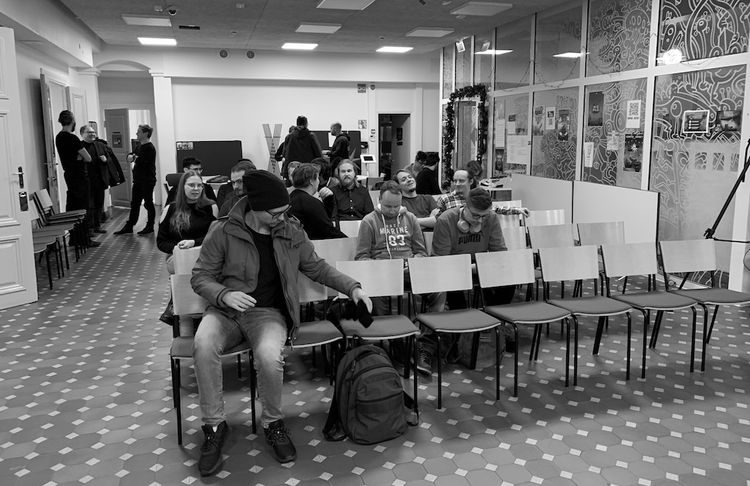EGD News #87 — Dealing with uncertainty


Sent on June 18th 2021.
If you aren’t a subscriber to EGD News, you can subscribe here.
It’s Joakim here. Greetings from Helsinki!
As you may know, the Elite Game Developers podcast turned two on June 4th, and I am continuing the celebrations here in the newsletter. To celebrate, I wanted to highlight three of my favorite founder podcast episode from the two years of podcasting.
EGD 079: Anton Gauffin, Huuuge Games
EGD 081: Hakan Ulvan, Bigger Games
EGD 059: Emily Greer, Double Loop
Now, onto the news.
🎮 Gabe Leydon on Invest Like the Best
I really liked this podcast episode with Gabe Leydon, founder of Machine Zone, makers of Game of War, on Invest Like the Best. He talks about so many exciting things and ideas that aren’t talked about enough.
I wanted to share my highlights from that conversation, where Gabe shares more about gaming, free-to-play, and NTFs.
Pitching a games company to VCs
When you pitch video games, the first slide in your deck should be “Why you’re not like Zynga.” For a decade, if you were making a video game company, you’d spend the first 30 minutes talking about why you’re not like Zynga because that’s all these guys know about.
These financiers are jealous of the retention. They’re jealous of the engagement. They like the monetization, but they don’t like video games. But it’s also really mysterious to them. They have no idea what [the game] is.
So when you go in and pitch a video game, it just becomes a funnel analysis conversation. What do your installs cost? What’s your retention like? That’s all they care about. And then you have to convince them that you can keep doing that.
Some people are building products that add gamification. [Gamification] adds this level of mystique to your product that VCs can’t quantify, but they like it. You see this big push towards that because [gamification] makes them seem cool or interesting in a way that [VCs] can’t comprehend. And then they hope you end up being like the Fortnite of email apps.
On game design
The qualities of a game [are]
- variable outcome,
- frequency, and
- sense of control.
These are three things that create addiction. The human brain is built to learn and it needs to learn. It cannot be stuck in a state of learning.
When you have variable outcomes, you can’t predict what will happen next, and then it happens frequently. Then you layer in “the game,” which is a sense of control. If you [have] some interface between this variable outcome thing you’ve designed, the brain doesn’t know what to do. It gets trapped in a learning state and starts inventing ways out.
This is how you end up with [things like] a lucky rabbit’s foot because the brain is freaked out about not being able to figure out what’s going on. It’s going to start inventing patterns.
The games I made [were] for a different mindset. Game of War and Mobile Strike. Those games were social, volatile, and more about belonging to something and being in the mix of something than about spinning a wheel over and over again.
On Free-to-play economies
Chinese games are very different than American games. You often hear about Chinese apps that have a game design in them. You hear these things like everybody’s got to buy Celery on the same day.
Everybody in America and the VCs is like, why can’t that work here? I’ll tell you why. The reason is that Americans, especially the developers hate that stuff. They don’t want to build it. They don’t want to make it, and they don’t like it. They think it’s manipulative. But they do like it at their core, so when they see it, they see something going on in China, and then developers water it down until they feel good about it. And then it doesn’t work. It happens over and over again. Cosmetics are an American thing.
If you go to Japan, it’s all loot boxes. If you go to Korea, it’s boxes, plus item shops. If you go to China, it’s just like straight item shops, in the Chinese ways. It’s winning because it’s just so much more direct. They got games a lot later than everybody else. They got the Korean version of video games, and that fits better with the internet world. Whereas the Americans are stuck with the arcade world, trying to make it work online. So you end up with cosmetics.
On NFTs
[At Machine Zone,] we would make items for the game and they would make millions of dollars in an hour. The thing that enabled that was all the security around the item. Like you had to buy it for me.
Now we’re seeing NFTs where instead of a game developer creating the security around the item [inside a game], we have Etherium creating that security. So literally everybody on earth now has the same monetization abilities that a video game has. And you’re seeing the same results, like 3LAU doing $11 million dollars of MP3s in a few hours.
I see everybody getting into [NFTs.] Even like your local cafe. Everybody’s going to be doing this because you can and because it will make a lot of money. When I saw this I was like, oh my God, everybody’s going to be running a Live Ops team. Everybody’s gonna say “Get online at noon!” and buy one of thirty of these things that unlock access to the VIP room, to events, or whatever.
I’m really excited because I think [NFTs are] going to fundamentally change everything about digital goods. Any business can sell speculative or rare digital goods. It’s going to fundamentally change every business and it’s a good time to be a game designer.
Listen to the full conversation by going here.
😩 Dealing with uncertainty
I want to continue talking about this one Twitter tweet I wrote a while ago.
“The worst enemy for failing and learning is the sunk-cost fallacy. You don’t want to give up since you’ve invested so much. How to avoid: fail fast by treating all your projects as experiments that will either work or not.”
I’ve been in game projects where the project would last from 18 months, and there was no evidence that the game would be fun unless all the missing parts would be put together. Often this meant assembling new technology that the game required to run. That meant 12 months of development time for the game to be fully operational.
Then there would be a need to build out several game modes for the players, like PVP, as one game mode wouldn’t be enough. The amount of work was immense, but everyone thought that the fun wouldn’t be discoverable unless all the missing pieces are in place.
New projects like the above mentioned are kicked off every day by countless game companies. They take on a lot of risks. They argue that they will be building the next PUBG, the next Pokemon Go, the next Trivia HQ, or the next Teamfight Tactics. Multiplayer, real-time action, and persistent gameplay are what gamers crave.
If you want to go after PUBG, can you break the project into two parts where the first part lasts two months? After two months, you got to have something that players can try out. If you are building a mobile game, can you launch it on Google Play? If you are doing a PC game, could you launch a smaller version on Steam? Maybe you dumb down the tech, limit how many players can play simultaneously? But what you want is to have a few hundred people off the street, playing your game, and you want to be measuring their behavior with the game. Are they getting into the game, are they progressing, and are they coming back?
If you aren’t satisfied with how they are coming back, you start over, and you’ve only lost two months instead of 12 or 18 months.
By creating game projects as multiple small experiments, you get into the mindset of the scientist. You aren’t going after the outcome in 18 months, but you are curious about what each experiment yields as evidence of something that is working. You can kill and start over if needed.
🎙 Jernej Cesen, Outfit7
Jernej Cesen is GM and SVP of Distribution & BI at Outfit7, the makers of Talking Tom. With Jernej, we talk about being knowledgeable about your market, how you understand the players and the opportunities, and what it’s like to operate with a big gaming IP like Talking Tom.
Here are my highlights from the discussion with Jernej.
Outfit7 is a very successful and growing company. What is your take on independent teams and making this Supercell style of game-making work?
Based on the results, [Supercell’s] model is working. For Outfit7, we were thinking about this direction. But if you have one strong IP and you are creating a data ecosystem around it, you cannot leave the teams to go with their own crazy ideas. Things need to be aligned and certain processes and knowledge needs to be shared.

But we are now moving into new IP where the approach is different. [The] empowerment of people is really important. Giving them the freedom so that they can think out of the box. This is the only way how you can create something new and become a trendsetter, not just the trend follower.
How would you build a BI (business intelligence) team from scratch?
The first thing that I would do, I would simply ask “Why do I need a BI?” and what do we want to achieve with it? [I wouldn’t hire] data scientists but I would hire market researchers that are dealing with data, but not going too much into the details. This is a good approach because they will look more from the perspective of users and the product.
Then you start building also a proper data analytics team because it’s important to know what is happening in the app. [They should] work closely with the product. If product [people] are thinking “I want to develop the app in this direction,” then the analytics needs to know about it. They shouldn’t be treated just as a service but as a part of the team. Otherwise, if you’re just servicing out the analytics part, you’ll get the standard reports without any value.
[Also do] user testing. Proper testing on proper users. If you just have [a lot of analytics], in the end, you might have a huge amount of data without any meaning because you will not exactly know what to do with it.
How do you identify and measure virality?
It’s hard to even identify what virality is. It might be something that there is a bunch of guys that like some feature and start making jokes out of it and then it goes viral. We need to identify those potential points in the game.
We are also testing virality with influencers, with TV ads. We did a test and we saw that there is a bump happening [in installs]. And we got completely new users, ones that are not familiar with our brands. They were maybe not even gamers, but when they saw something on their main communication channel, which is TV, they say, Okay, let’s give it a try.
It makes sense to try different things and it’s also important that you know how to measure them.
Listen to the full episode by going here.
This newsletter is sponsored by Favro

📃 Articles worth reading
+ Bitcoin is equity, not money — “Lots of things, from baseball cards to cases of Château Lafite, go up in value. That does not make them money. It makes them assets.”
+ No Meetings, No Deadlines, No Full-Time Employees — “Today, when I’m asked how many people work at Gumroad, I respond with “ten or so.” That’s how I convert the number of people we have into what others expect. But the truth is more complicated: If we include everyone who works on Gumroad, it’s 25. If we include full-time employees, it’s none. Not even me. We have no meetings, and no deadlines either. And it’s working: our creators earn over $175 million a year, and we generate $11 million in annualized revenue, growing 85% year-over-year.”
+ Supercell’s secret for growing Brawl Stars to a $1 billion success — “More than half of the maps in the game today have originated from community competitions or the in-game Map Maker. We are constantly implementing features and quality of life changes based on community feedback, alongside letting users vote on skins created by individual artists through Supercell.”
+ How Netflix could become the ‘Netflix of Gaming’ — “Over the years, there have been a number of services trying to become the Netflix of gaming: Xbox Games Pass, Playstation Now, Apple Arcade, Geforce Now, EA Play, and the Google Play Pass among them. But now, thanks to this tantalizing report we get to wonder, what should be the gaming of Netflix?”
💬 Quote that I’ve been thinking about
“The only thing we know about the future is that it will be different. Trying to predict the future is like trying to drive down a country road at night with no lights while looking out the back window. The best way to predict the future is to create it.” — Peter Drucker
This newsletter is sponsored by Opera Event
Looking for some great new authentic video creative? Try something totally new with Influencer Generated Content (IGC) by Opera Event. Influencers or actors will make specific creative content for your games and Opera Event will deliver you high-quality video ads that highlight the best parts of your game.
Note! You get a free video with the purchase of 4 or more videos. Remember to say that Elite Game Developers sent you!
Go to www.getigc.com to see some examples and get more information.
If you’re enjoying EGD News, I’d love it if you shared it with a friend or two. You can send them here to sign up. I try to make it one of the best emails you get each week, and I hope you’re enjoying it.
I hope you have a great weekend!
Joakim





